2007 VOLKSWAGEN GOLF child lock
[x] Cancel search: child lockPage 210 of 444
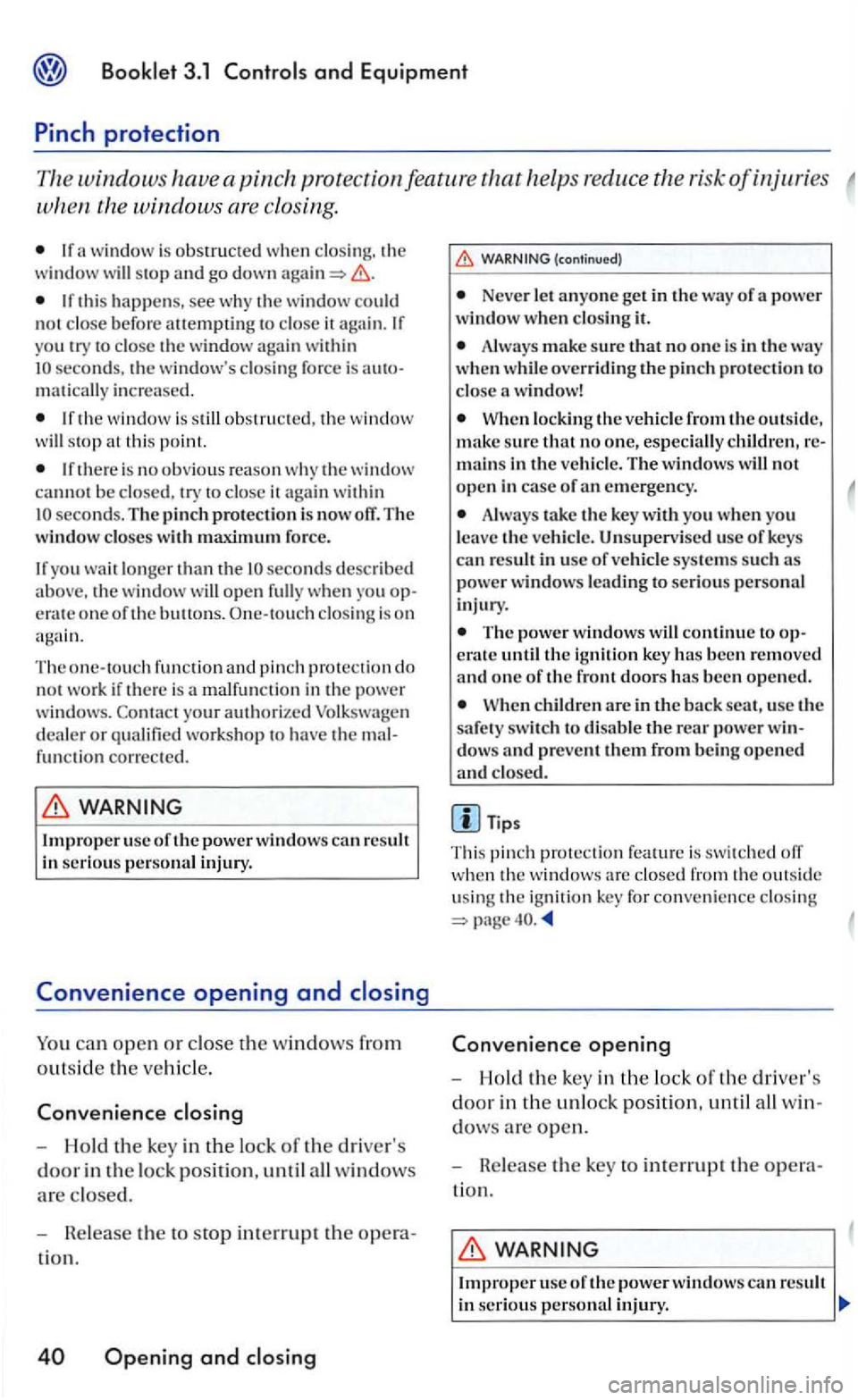
Booklet 3.1
If window is obstructed w hen clo sing. the window will stop a nd go down
If th is happens, see wh y the window co uld not close before attempting to close it a ga in . If
yo u try to close the window again within seconds. the window's clo sing force is m ati cally inc reased.
thi s po int.
If th ere is no obvious rea son why the cannot b e closed, try to close it again w ithin second s. Th e p inch pro tecti on i s now
If yo u wait longer than the seconds desc ribed above. the wi ndow will open fully when
The one-to uc h f unctio n and pinch protection d o
no t work if th e re is a m alfunction in the power
w indows. Contact your authorized Volkswagen dealer or qualified workshop to have the fun ction corrected.
WARNING
Improper use of the power windows can res ult in serious personal injury .
Convenience opening and
You can open or th e w indows from
o
uts ide the ve hicle.
closing
- Hold th e k
ey in
-Release the stop in terrupt the
WARNING (continu ed )
Neve r let anyo ne ge t in the of a power window w hen closi ng it.
make sure that no o ne is in the w hen window !
Whe n locki ng the ve hicl e from th e o uts ide, make sure that n o o ne, especi ally children , m ain s in the vehicle . T he windows will not open in case of em ergency.
ta ke the key with yo u when you leave the vehicle. Unsupervised use of keys can result in use of ve hicl e system s s uch as power windows leadin g to serious person al
in ju ry.
Th e power wi ndows will continue to
When chil dre n arc in t he back seat, use t11c safe ty sw itch to disabl e the rear power dows and prevent them fro m being opened and closed.
opening
- Hold th e ke y in th e lock of th e drive r's
door in th e unlock posi tio n, until all
dows are open.
- Hel
ease th e key to interrupt the
tion.
WARNING
Improper use of the power window s can res ult in seriou s personal injury.
Page 225 of 444

Booklet 3.1
passe nger's seat can
b e adju ste d in many ways to suit the physical
need s of the vehicl e occ upants. position is
very important for:
fast and easy operat ion of all control s on the instrument panel,
safe driving ,
optimum prote ction from the s afet y belts
and airb ag booklet 2.1
Driv ers or passengers who are unbelted, out of position or too close to the airb ag can be seri
ously injured or killed by an airbag as it unfolds. To help reduce the risk of serious personal injury:
Always adjust th e driver's seat and the steeri ng whe el so that there are a t lea st in ches (25 em) betwe en you r brea stbone and the ste erin g w heel.
Always hold the steering wheel on the out
s ide of th e s teering wheel rim with your hands at the 9 o'clock and 3 o'clock position s to he lp
reduce the risk of personal inju ry if the driver 's airbag inflates.
Never hold the steering wheel
Passengers must always sit in an upright position and never lean agains t or pl ace an y
(co ntinued)
part of their body too close to the area where the airbags are loca ted.
Alway s make sure there are at least inch es (25 em) between instrument panel.
Eac h passenger must always sit on a sea t of their own and prope rly fasten and wear the safety belt belon ging to that scat.
Before driving, always adjust the front
seats and head r estraints properly.
Never adju st th e sea ts while the vehicle is
moving. sea t may move unexpec tedly and yo u could lose control of the vehicle.
Always keep your feet on the floor in front of the sc at. Never rest on tl1e in strument panel, out of the window, etc. The airbag
s ystem and safety belt will not be able to pro
te ct you properly and can even increase the
ri sk of injury in
Never drive with backres t reclined or tilted far backJ The the backres ts are t ilted back, greater risk of injury due to
incorrect positioning ofthe safety belt and im
proper seating position.
b elts only offer maximu m prot ec
tion when the se atback is securely lat ch ed in
Children must alway s ride in child seats.
Seats and storage 55
Page 254 of 444
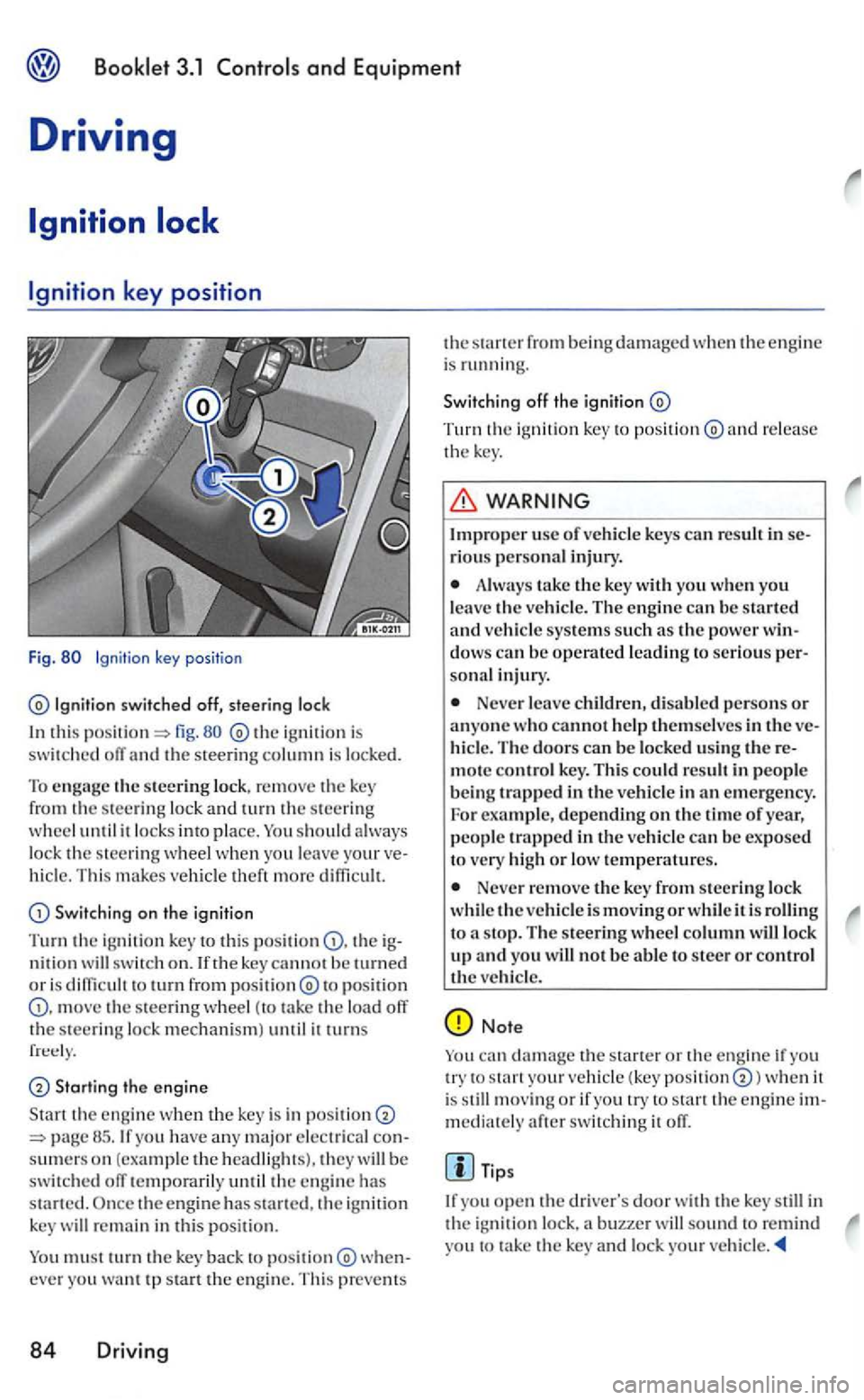
Booklet 3.1 Controls and Equipment
Driving
Ignition
key position
Fig.
switched off, steering loc k
this fig. ig niti on i s swit c h ed off an d the ste erin g column is locked.
T o engage th e s teering lock . remove the key
from th e s teering lock a nd turn the s teerin g wheel u ntil it locks into place. You sh o uld lo ck th e s teering when you leave vehicl e. T his m akes ve hicle th eft m ore diffi cu lt.
Swi tch ing on th e ignition
Turn the ignition key t o this th e ig
n iti o n sw itc h on. lfth e key cannot be turned o r i s to turn from to p osition th e steering wheel (to tak e the load off the s teering lock mechani sm ) until it turns
Starting the e ng in e
Sta rt th e e ng in e when the key is in posit io n have any m ajo r e lectri cal consumers on (example the headli ghts). they
re mai n in thi s posi tion.
Y o u
must turn th e key back to
Tu rn the ig ni tio n key to po sition re lease
t h e key .
usc of vehicle ke ys can result in se
r iou s personal in jury.
Alwa ys take the key with yo u when you leave th e ve hicle. The engine can be starte d
and vehicl e sys te m s such a s the pow er windows can be operate d leading to serio us persona l injury.
N ever leave children, di sabled perso ns or anyone who ca nnot help themselve s in the ve
hicle. The doors can be locked u sin g t he re
mote con tro l key. This could res ult in people b e ing trapped in the ve h icl e in an emergen cy .
For example, depending on the tim e of year,
peopl e trapped in the vehicle can b e exposed to very high or lo w temperatures.
Never re m ove the key from steering lock
w hi le the vehicl e is movi ng or w hil e it is to a s top. The s teerin g wheel column will lock up and yo u w ill not be able to steer or contro l the vehicl e.
Note
yo u try to s tart your ve hicl e (k ey position when it
is still mov ing or if yo u try s ta n the en gin e immediate ly after switc h in g it off.
yo u open th e in
the i g nit ion lock, buzzer yo u to take the key and lock your ve hicle.
Page 265 of 444
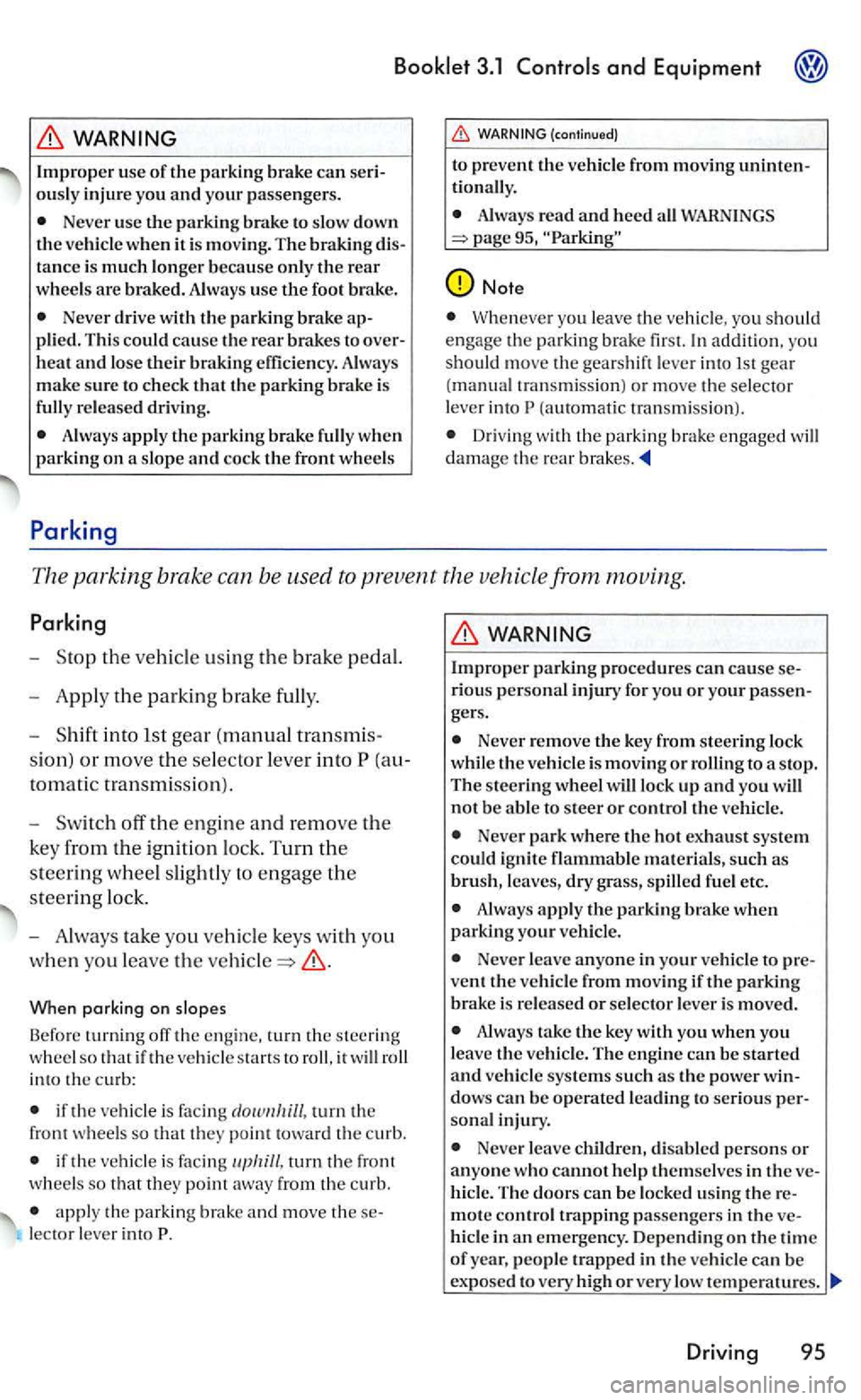
Booklet 3.1 Controls and Equipment
WARNING
Improper use of the parking brake can seri
ousl y injur e yo u and your passenge rs.
Neve r use the parking brake to slo w down
th e ve hicle when it is mov ing. The braking tanc e is much longer because only the rear wheel s are braked. Alwa ys use the foot brake.
Neve r drive with the parking brake plied. This could cause the rear brakes to overheat and los e their braking efficiency. Always
make sure to check that the parkin g is
fully re le a sed dri vin g.
Always apply the parking brake fully when
parking on a slope and cock the front wheels
Parking
(co ntinue d)
to prevent the vehicle from moving
Always read and h ee d WARNINGS
Whe never you leave th e veh icle, you should engage the parkin g
(aut om ati c tra nsm ission) .
Driving w ith the parking brake engaged will damage the rear
The parking bra ke can be used to prevent th.e vehicle from moving.
Parking
-the vehicle using the brake
-Apply th e parkin g brake full y.
-
into lst gear (m anual transmi s
sio n)
or move the se lector lever into
When parking on slo pes
Before turn ing off the engine, turn the steering
w hee l so that if th e vehicle starts roll, it will roll into the curb:
if the vehicle is facing turn the
f ront wheels so that they point toward the curb.
if th e veh ic le is facin g
apply the parkin g brake and m ove theselector leve r into
WARNING
Improper parki ng procedures can cause riou s personal injury for yo u or your passe n
gers.
Neve r remove the key from steering lock
while the ve hicl e is moving or rolling to a s top . The steering wheel will lock up and yo u will not be abl e to steer or contro l th e vehicle.
Neve r park where the hot exhaust system could ig nit e flammable materi als, such as brush, leaves, dry g ra ss, spill ed fue l e tc.
A lwa ys apply the parking brake when parking your vehi cle.
Neve r leave anyone in your vehi cle to vent the ve hicle from movin g if the parking brake is released or selector lever is moved.
Always take th e key with yo u when you leave the vehicle. The engin e ca n b e started and veh icle syste m s s uch as the powe r dows can be operated leadi ng to serious sonal injury.
Neve r leave childre n, disabl ed person s or anyone w ho cannot h elp th e mselves in the hicle. The doors can be locked using th e re-
m ote control trapping passe ngers in the h icle in an emerge ncy . Depending on the tim e of year, peo ple trapped in th e vehicle can be ex po sed to very high or very low temperatures.
Driving 95
Page 269 of 444
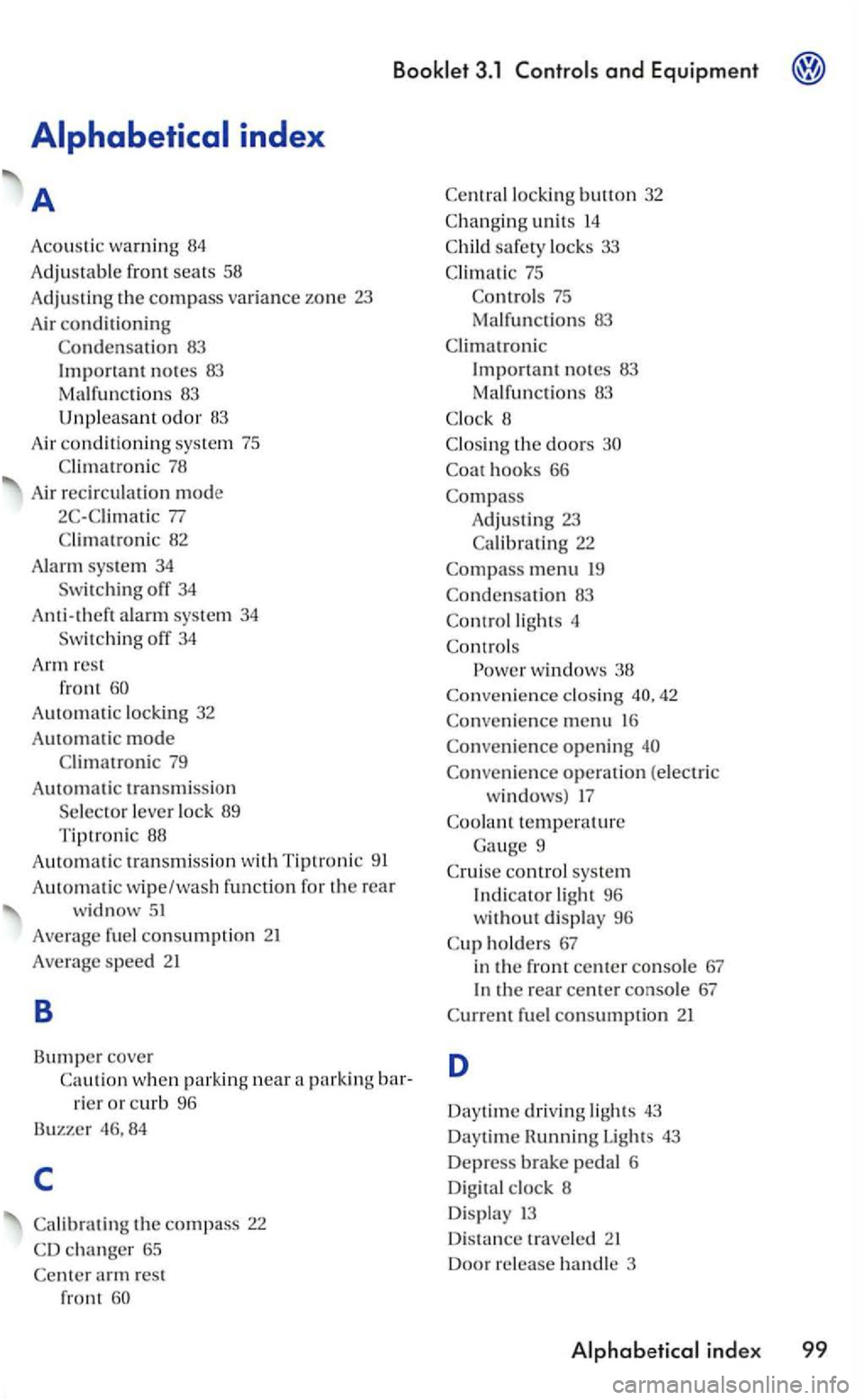
3.1 and Equipment
Average fuel consumpti on 21
Average spe ed
B
Bumper cove r
Ca ution when parkin g near a parking
rier or curb 96
Buzzer 46,
84
c
Calibrating the compass 22
CD changer 65
Center arm rest
fro nt
Child safety loc ks 33
Clima tic 75
Controls 75
Malfu nctions 83
Climatronic
Important notes 83
Ma lfunc ti
ons 83
C
lock 8
Clos ing the
doors
Coat hooks 66
Compass
Adjusting 23
Calibrating 22
Compass menu 19
Condensation 83
Control lights 4
Controls
w indows 38
Convenience closi ng
D istance tra veled
Doo r re lease handle 3
ind ex 99
Page 271 of 444
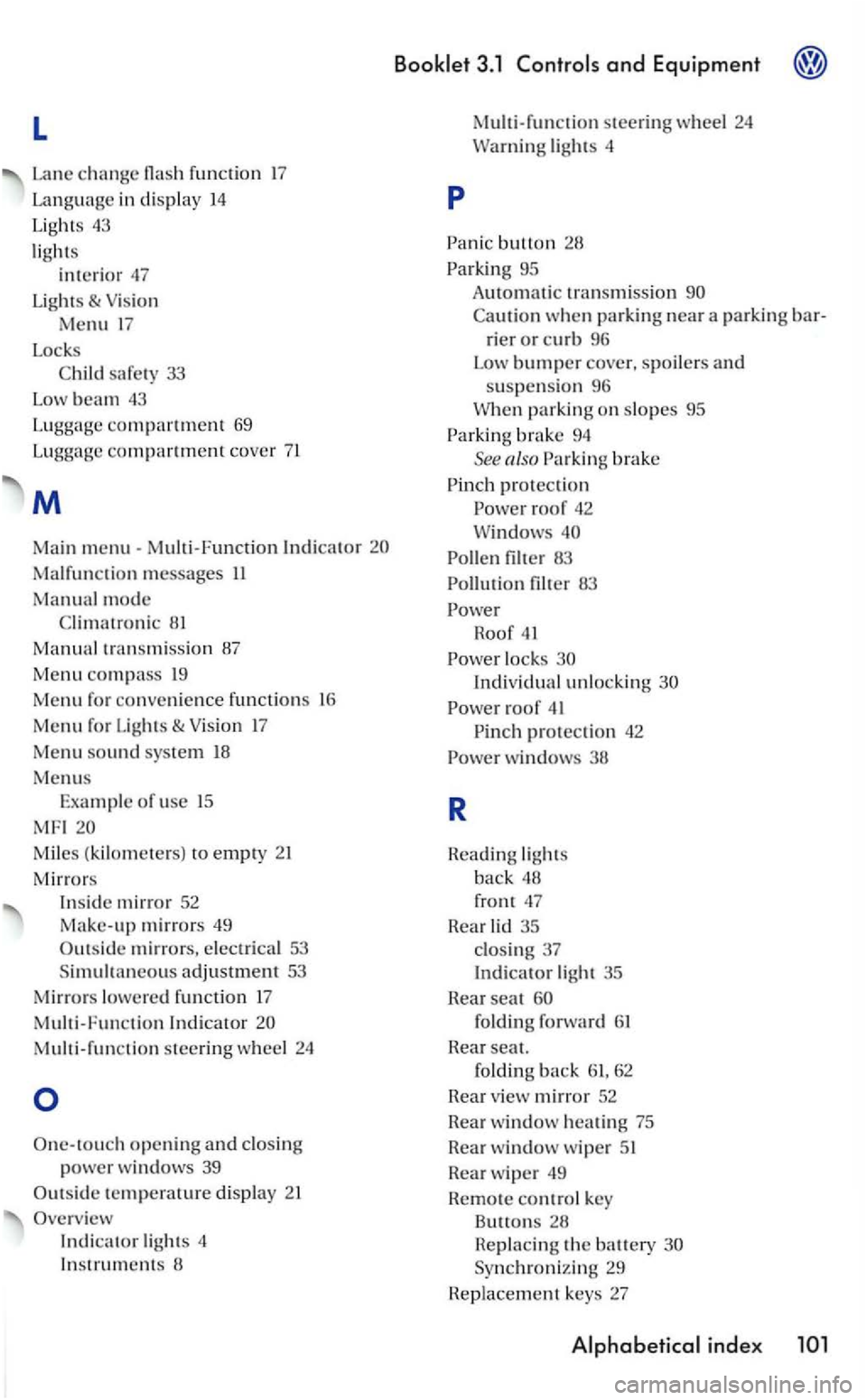
L
Lane c hange function
Language in display 14
L ight s 43
lights interior 47
Lights & Vision
Menu
Locks
Child
safety 33
M
Main menu-Multi-Funct io n
Malfun ction messages
Manual mode C limatronic
Manual tra n sm issio n
Menu compass 19
Menu fo r conven ience fu nctions 16
Menu for Lights & V isio n 17
Menu sound system
Menus
Exam ple of use 15
MFl
mirrors, electrical 53
Sim ultaneous adjustmen t 53
Mirrors lower ed function 17
M
ulti- Fun ction
Multi-fun cti on steering wheel 24
opening an d closing
power windows 39
Indica to r lights 4
button
bumper cove r. spoilers an d
s u spe nsi
on 96
When parking on slopes 95
brake 94
See also brake
p rotection roof 42
Windows
filter
filte r
loc ks lndividualunlocking
roof 41
p rotec tion 42
windows 38
R
Reading lights
back
47
Rear 35
clo sing 37 Indicator light 35
Rear seat folding forwa rd 61
Rear seat.
folding ba ck 61. 62
Hear view mirror 52
Hear window heating 75
Hear window wipe r 51
Rear wiper 49
Remot e control ke y
B u
ttons Repl acing th e battery
ind ex
Page 330 of 444
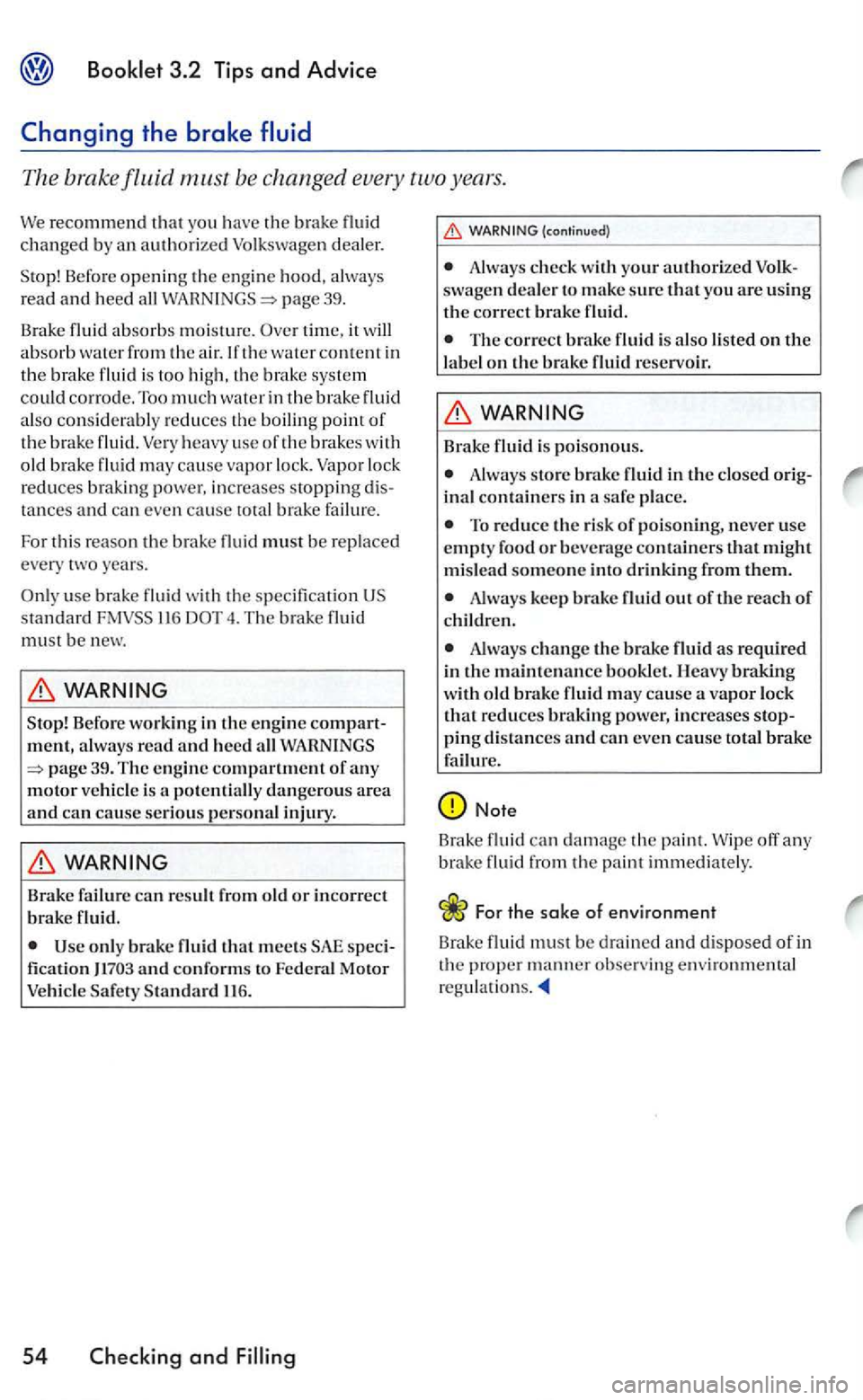
3.2 Tips and Advice
The brake fluid be changed every two years.
We recommend that you have the brak e changed b y an authorize d Volkswagen dealer.
S top! Be
fore openin g th e e ngin e hood, always
read and heed all page 39.
Brake fluid
absorbs m oisture. time, it will absorb wate r from the air. the wa ter content in the brak e fluid is too high, the brake sys te m
c
ould corrode. Too much wa te r in the brak e fluid
a lso consid erably reduces the boilin g point of the brake fluid. Very heavy use of th e brak es with
old brake fluid may cause vapor lock . Vapo r lock
reduces braking power, in cre ases stopping tances and can eve n cause total brake failu re.
For this r
eason the brake fluid must be repla ced
every two years.
use brak e fluid the s pecification U S standard 116 4. The brake fluid must be new.
Stop ! Befor e working in the engine compartment, always read and h eed all WARNINGS 39. The engine compartment of any motor vehicl e is a potentiall y dangerous area and can cause seriou s persona l injury .
Brake failure can result from old or incorrect brake fluid.
fica tio n
(continued)
A lwa ys check with your authorized swage n deale r to make sure that you arc u sing the correct brake fluid.
The correct brake fluid is also listed on the
labe l on the brak e fluid reservoir.
Always store brake fluid in the closed
To reduce th e risk of poisoning, neve r us e empty food or beverage containers that mi ght mislead someone into drinking from them.
A lwa ys keep bra ke flu id out of the reach of childr en.
Alway s change th e b rake fluid as required in the maintenance bookl et. Heavy braking w ith old brake fluid may cause a vapor lock that reduces braking power, increases ping distances and can even cause tota l brake failure.
Note
Brake fluid can damage the pai nt. Wip e off any
brake fluid from rh c paint immedia tely.
For the sake of environment
B rake fluid
must be drained and disposed of in
th e proper manner obse rv ing env ironmental
Page 331 of 444
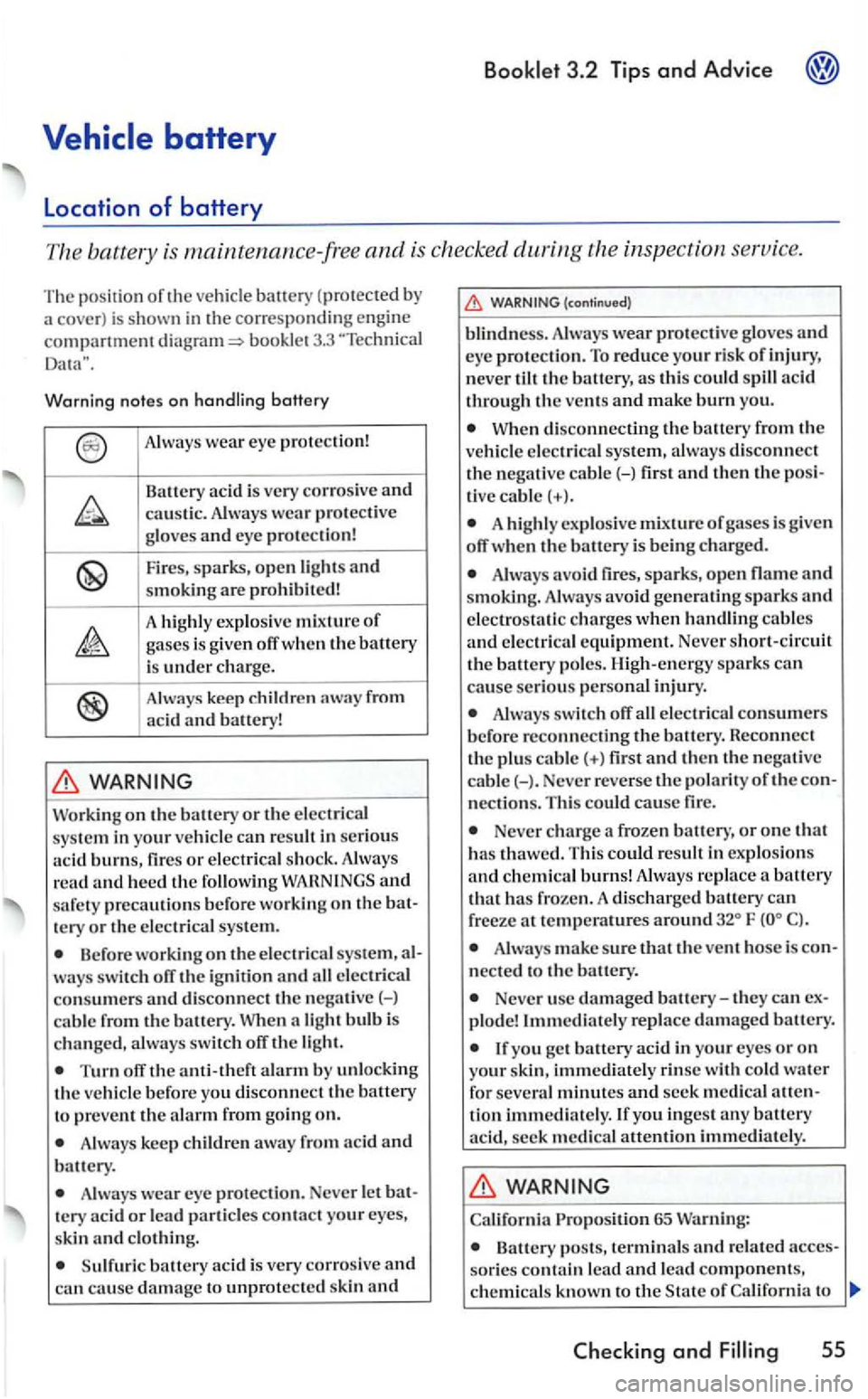
booklet 3.3 ""Technical
Warnin g notes on hand lin g battery
p ro tect ive
g loves an d eye protect ion!
Fir es, sparks, open lights and smoking are prohibi te d !
hi ghl y ex plo sive mixtu re of is give n off whe n the battery
i s under c h arge.
keep frn m
acid and battery !
WARNING
Working on the battery or th e e lectri ca l
sys tem in your vehicl e ca n res ult in serio us
acid burns, fires or elec tri ca l s hock . Always
read and heed th e follow ing W/\HN INGS and
safe ty preca utions before work ing on th e
Befo re wo rking o n th e electrica l system, ways switc h off the ignit ion and all elec trical
co nsumers and disconnect the nega tive(-) cabl e from the battery. When light bu lb is
changed, always switc h off th e light .
Turn ofT the anti-theft ala rm by unlockin g the vehicl e before you disconnect the ba ttery
to preve nt the from on.
A lway s kee p children
Always wear eye protection. Never let tery acid or lead particles contact your eyes ,
s ki n and clothing.
Sulfur ic battery aci d is ve ry corros ive and can cause damage to unp rot ected skin and
(continued)
blind ness. Always wear protective g loves an d
eye pro tectio n. To reduce your risk of injury, n ev e r tilt the battery, as thi s could spill acid
th ro ug h th e vents and m ake burn yo u.
W he n disconnec ting the ba tt ery fr o m the vehicl e electrica l sys te m , a lways disconnec t
th e nega tive cable(-) fir st and th en th e tive cable(+).
A hig hl y exp los ive mixtu re of is given
off w he n th e battery is being charged.
A lway s avoi d fires, sp a rk s, open and sm oki ng. Always avoid generati n g sparks and electros ta ti c ch arges when h andling cabl es
and e lec tric a l equipme nt . Neve r sh o rt -ci rc u it
th e ba tte ry po les. High-energy sp a rk s can
ca u
se serio us personal injury.
Alway s switch off all electri cal consumers befo re reconnec ting the batt ery. Recon nect
t h e plu s ca ble(+) first and then th e negat ive
cable(-). Never reve rse the po larity of the
Never ch arge
F C).
Alwa ys make su re that th e ve nt hose is nect e d to the battery.
Neve r usc dam age d battery-they can plode! Immed ia te ly rep la ce dam age d battery.
tion immediately. lfyo u in ges t any batt ery
a cid , seek medic al atte ntion immedia tely.
WARNING
Ca lifornia 65 Warning:
Battery posts, termina ls and re la ted sories con tai n lead a nd lea d compo ne n ts ,
c h em ica ls known to the
and